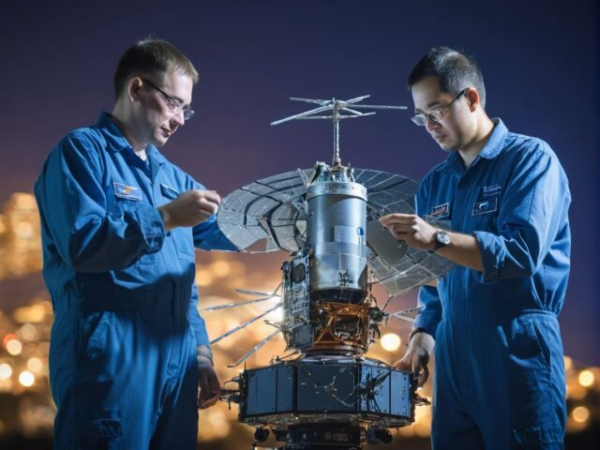In today’s digital age, satellite communications engineering is the backbone of our interconnected world. Whether it’s facilitating GPS navigation or providing global internet access, satellite systems are essential to modern infrastructure. The demand for reliable, efficient satellite networks has never been higher, and the work of satellite communications engineers is critical in meeting that need. They design, develop, and maintain systems that transmit data, voice, and video over immense distances, connecting people across the globe.
What is Satellite Communications Engineering?
Satellite communications engineering focuses on creating and managing systems that transmit information via satellites. These systems serve a range of purposes, from enabling telecommunications to powering global positioning and remote sensing. Engineers in this field develop the technology that makes it possible to transmit signals across vast distances, often reaching areas where terrestrial networks cannot.
Key Responsibilities of Satellite Communications Engineers
Satellite communications engineers have a broad range of responsibilities. Here’s a breakdown of their key functions:
System Design
Engineers are tasked with designing satellite systems that meet the coverage and performance needs of the end-users. They carefully balance factors such as coverage area, data capacity, and frequency bands, all while keeping costs in check.
System Development
Building these systems requires the creation of both hardware and software. Engineers develop antennas, transmitters, and receivers that form the backbone of the satellite communication network.
Testing and Deployment
Before a satellite is launched, engineers test its systems to ensure they can withstand the rigors of space. This phase is critical to ensuring reliable performance once the satellite is deployed.
Operations and Maintenance
Once a satellite is in orbit, engineers monitor its performance and address any issues that arise. This includes ongoing maintenance and occasional system upgrades to ensure the satellite continues to meet operational needs.
Types of Satellite Communication Systems
Satellite systems are typically categorized based on their orbit, function, and frequency. The two primary types include:
Geostationary Satellites (GEO)
Orbiting at a fixed position relative to the Earth’s surface, geostationary satellites provide continuous coverage over specific regions. They are widely used for telecommunications, broadcasting, and weather monitoring.
Low Earth Orbit Satellites (LEO)
LEO satellites orbit at much lower altitudes, typically between 500 to 2,000 kilometers. They are crucial for applications like GPS navigation, satellite internet, and imaging systems.
Engineering the Future: The Satellite Development Process
Creating a satellite system is a multi-stage process that involves meticulous planning, precise engineering, and collaboration across various disciplines. Here’s a look at the stages involved:
Planning and Design
The first phase involves setting clear objectives, such as determining the satellite’s mission, coverage area, and the type of data it will handle. Engineers must consider factors like signal strength, interference, and orbital path during the design phase.
Building the Satellite
After planning, engineers move on to building the satellite. This involves constructing antennas, solar panels, and propulsion systems. The satellite’s communication components, including antennas and transponders, are of particular importance, as they handle the transmission and reception of signals.
Launching the Satellite
Once the satellite is built and thoroughly tested, it’s ready for launch. Engineers collaborate with aerospace partners to ensure the satellite is safely delivered into its designated orbit. Post-launch tests are conducted to verify that all systems are functioning correctly.
Ongoing Management
Once operational, the satellite requires continuous monitoring. Engineers work from ground stations to ensure it’s functioning correctly and may make software updates or system adjustments as needed to optimize performance.
The Technology Driving Satellite Communication
Advanced technology is at the heart of satellite communication systems, enabling the transmission of data across the globe.
Antennas and Transponders
Antennas are responsible for sending and receiving signals between the satellite and ground stations. Engineers design these antennas to be highly efficient, ensuring minimal signal interference. Transponders, which receive and retransmit signals, are built to handle multiple frequencies, allowing for greater data transmission.
Frequency Bands
Different satellites operate within specific frequency bands based on their function. The most common bands include:
- C-Band for long-distance communication
- Ku-Band for satellite television and internet services
- Ka-Band for high-speed data transmission
Challenges in Satellite Communications Engineering
While satellite communications engineering opens new frontiers, it also presents several challenges.
Signal Interference
Weather conditions, physical obstructions, and electromagnetic interference can disrupt satellite signals. Engineers must design systems that can withstand and mitigate these interruptions.
Latency
Geostationary satellites, because of their distance from Earth, experience higher latency. Engineers work to reduce this delay by optimizing the signal processing and transmission times.
Cost and Complexity
Building and launching satellite systems is expensive. Engineers must ensure that these systems are both high-performing and financially viable, balancing cutting-edge technology with budget constraints.
Emerging Trends Shaping the Future
Satellite communications engineering is evolving to keep pace with technological advancements and growing global demand.
5G Integration
With the rollout of 5G networks, satellite systems are being integrated to provide global high-speed internet, particularly in remote areas lacking terrestrial networks.
Small Satellites (Smallsats)
Smallsats are compact, lightweight satellites that are cheaper to launch and can be deployed in constellations to cover broader areas. They are increasingly being used for communication, navigation, and Earth observation.
Quantum Communication
Quantum encryption is an emerging technology that promises ultra-secure communication channels via satellites. Engineers are exploring how to implement this cutting-edge technology for highly secure data transmission.
Conclusion
Satellite communications engineering is crucial for maintaining global connectivity, with engineers leading the development of systems that power our interconnected world. As new technologies like 5G and quantum communication emerge, satellite engineers will continue to innovate, ensuring that these systems meet the growing demand for reliable, high-speed data transmission.
The future of satellite communications holds immense promise, with engineers at the forefront of this rapidly evolving field, driving new solutions and overcoming the challenges of space-based communication.
